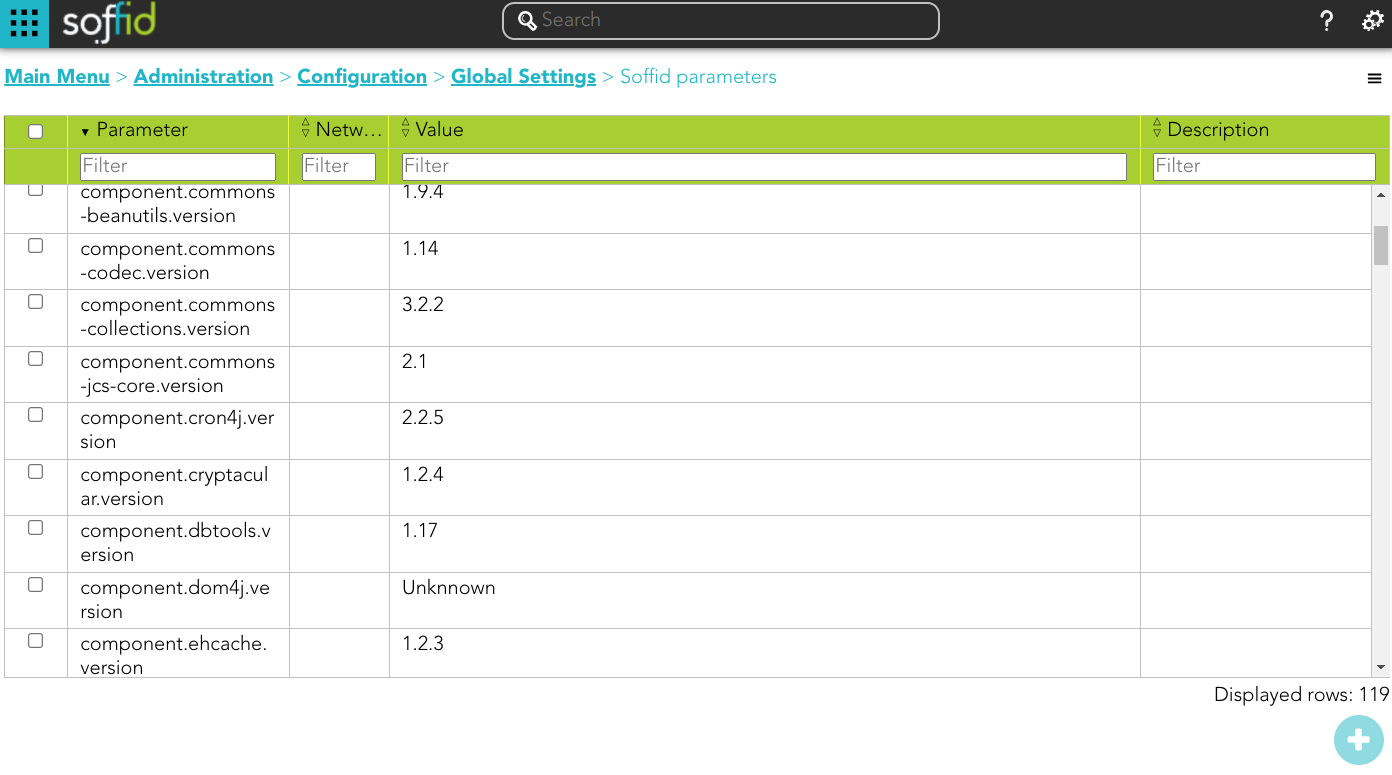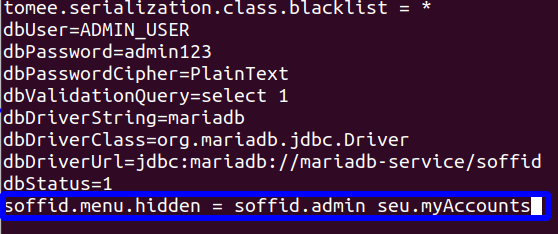Soffid parameters
Definition
Soffid allows you to customize the configuration of some attributes of the Console, Syncserver, connectors and add-ons.
There are several types of parameters.
- Informative parameters, such as the versions of internal components of Soffid.
- Parameters used as attributes in Soffid screens, such as the values of the look & feel fields.
- There are also parameters that can be modified, such as some configuration data for the synchronization server.
- There are new attributes that can be included to expand the functionality of Soffid, such as mail server data.
If you want to know the Soffid console version check the component.iam-core.version parameter.
Screen overview
Standard attributes
- Name: code used to identify the parameter.
- Value: parameter value.
- Network (optional): network to which this parameter would be assigned.
- Description (optional): a brief description of the parameter.
Actions
Soffid parameters query actions
|
Add new |
Allows you to add a new Soffid parameter. You can choose that option on the hamburger menu or clicking the add button (+). To add a new parameter it will be mandatory to fill in the required fields. |
|
Delete |
Allows you to delete one or more Soffid parameters by selecting one or more records and next clicking the button with the subtraction symbol (-). To perform that action, Soffid will ask you for confirmation, you could confirm or cancel the operation. |
|
Import |
Allows you to upload a CSV file with the parameter list to add, update or delete parameters to Soffid. First, you need to pick up a CSV file, that CSV has to contain a specific configuration. Then you need to check the content to be loaded, it is allowed to choose if you want or not to load a specific attribute. And finally, you need to select the mappings for each column of the CSV file to import the data correctly and to click the Import button. To delete a parameter, the values of the parameter have to be empty |
|
Download CSV file |
Allows you to download a csv file with the basic information of all Soffid parameters. |
Soffid parameters detail actions
|
Apply changes |
Allows you to save the data of a new parameter or to update the data of a specific parameter. To save the data it will be mandatory to fill in the required fields. |
|
Delete |
Allows you to delete a specific Soffid parameter. To delete a host you can click on the hamburger icon and then click the delete button (trash icon). Soffid will ask you for confirmation to perform that action, you could confirm or cancel the operation. |
|
Undo |
Allows you to quit without applying any changes. |
List of parameters sorted by functionality
Console
|
Parameter
|
Description
|
|---|---|
|
soffid.auth.system |
Select the managed system where the account name will be searched on the user login. Defaults to soffid. |
|
soffid.auth.trustedLogin |
Set to true to enable the Soffid console to validate passwords on trusted systems. Setting it to false, the password will be validated against internal tables only. |
|
soffid.delegation.disable |
Set to true to prevent users to delegate permissions from self service page. |
|
soffid.entitlement.group.holder |
Set to optional enables the operator to set a group as the group holder for any entitlement assignment. Set to always enforce that any entitlement assignment must be bound to a holder group. Set to none to disable this feature. This parameter affects to role holder |
|
soffid.language |
Enforce user interface language. |
|
soffid.language.default |
Default user interface language (en). |
|
soffid.network.internet |
Sets the name for a generic subnet that will hold any host not included on any listed network. |
|
soffid.proxy.trustedIps |
Set the IP address of any reverse proxy in front of Soffid servers. This parameter can take a list of IP addresses, separated by commas, like the following ones:
To allow a range of network IPS, one can use the wildcard(*) symbol, as in the following example:
Starting with Soffid console 3.3.0, the network-address/bits notation is allowed, as in the following example:
|
|
soffid.propagate.timeout |
Timeout in seconds to retry the password validation needed to propagate a managed system notified password change (requires syncserver 1.5.4). |
|
soffid.server.sharedThreads |
Number of shared dispatcher threads per synchronization servers (by default 1) |
|
soffid.syslog.server |
Hostname or IP address of server hosts SIEM. The SIEM will receive audit information using the syslog protocol. |
|
soffid.task.limit |
The maximum number of tasks allowed per transaction. If a simple or complex transaction generates more tasks than specified, these tasks will be kept on hold. Administrators can release them through the monitoring page. (version 2.0+) |
|
soffid.ui.docPath |
The path where to store report and workflow documents. |
|
soffid.ui.docServer |
URL where is the server to store the files. |
|
soffid.ui.docStrategy |
Class responsible for managing report and workflow documents. |
|
soffid.ui.docTempPath |
The path where to store temporary files |
|
soffid.ui.docUsername |
Username of the doc server. |
|
soffid.ui.docUserPassword |
The password of the doc server. |
|
soffid.ui.maxrows |
The maximum number of rows to display in searches. The default value is 200 but you can change it. |
|
soffid.ui.timeout |
Max time (in milliseconds) a query can take to complete (version 2.0 +). |
|
soffid.ui.wildcarts |
Setting the auto value enables the user interface to add wildcards on user queries. Setting it to off disables this feature. |
|
soffid.externalURL |
External URL to access to Soffid console. |
|
soffid.kerberos.agent |
The name of the Windows server agent so that any incoming Kerberos packets will be authenticated against that domain. |
|
soffid.pam.search.recordings.timeout |
Timeout reached in the query, use the parameter to specify a longer timeout in milliseconds. By default, if you don't config this parameter is 60000 milliseconds. (version 3.5.18+) |
|
soffid.nameformat |
Parameter to configure how to display the users full name. Where:
For instance: |
|
soffid.issue.next |
Allows you to initialize the parameter to indicate what will be the ID of the next issue. 1 will be the default value. |
|
soffid.upload.maxsize |
Allows you to set a maximum value in bytes for uploading files to Soffid. |
Syncserver
|
Parameter
|
Description
|
|---|---|
| SSOServer | This parameter indicates which server acts on the workstations that run SSO. This parameter can have different values for any subnet. So you can define ESSO servers allowed for any subnet. |
| seycon.https.port | Port where synchronization server connects to. This parameter is used by ESSO clients to connect to synchronization servers. |
| seycon.server.list | Shows where Syncserver and SyncServer backup is installed. When installing the first server synchronization, this parameter is automatically updated. If you want to install a synchronization server backup you must update this parameter manually. Note that proxy synchronization servers are not on this list. See the Soffid installation guide. |
| soffid.sync.engine.threads |
This parameter allows you to configure the number of threads available to run the tasks. If you do not fill this parameter, Soffid will run 1 thread for every 50 systems, but never more than twice the number of CPUs of the server. The value of the parameter must be equal or greater than 1. (Available in Sync Server version 3.5.15+) |
Mail server
|
Parameter |
Description |
|---|---|
|
mail.host |
Host to send electronic mail messages. |
|
mail.from |
Recipient address that will be set as the email sender. |
|
mail.transport.protocol |
Set to SMTPS to get secure mail. Default value "SMTP" to use plain SMTP protocol. |
|
mail.auth |
Set to true if your mail server requires user authentication. |
|
mail.user |
Set your email user name if your mail server requires user authentication. |
|
mail.password |
Set your email password if your mail server requires user authentication. |
|
mail.port |
25 by default, with this parameter a new port can be set. |
|
mail.smtp.sasl.enable |
Set to true to enable SASL. |
Job notifications
|
Parameter |
Description |
|---|---|
|
soffid.scheduler.error.notify |
Users to notify when a scheduled task fails. |
|
soffid.bpm.error.notify |
Users to notify when a BPM task fails. |
|
soffid.bpm.error.retry |
Set to true to always retry any failed BPM task. |
Syncserver provisioning
|
Parameter
|
Description
|
|---|---|
| soffid.server.register |
Set to direct value to bypass standard workflow needed for a syncserver to join the syncservers security network. Otherwise, the standard approval workflow will be required(Since syncserver 2.6.0). You also can set it to no-direct |
Addons
Federation
|
Parameter
|
Description
|
|---|---|
| addon.federation.essoidp |
Set the Identity Provider identifier to indicate that this will be the authentication provider. For more information, you can visit the How to add to ESSO a second factor of authentication page. |
Exclude menu options
To exclude default menu options for all users of the Sofid console, the following steps can be followed
1. To exclude some menu options from your Soffid console, you must edit the system.properties file of this console. You can find this file in the following path: /opt/soffid/iam-console-3/conf/
2. Add the soffid.menu.hidden parameter to the system.properties file. The value of this parameter can be the menu options name that you can find in the console.yaml file.
3. Restart the Soffid console.


